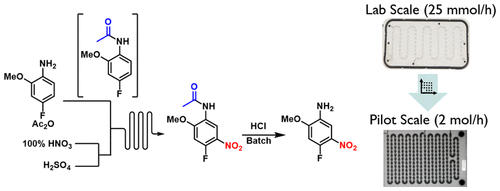当前位置:
X-MOL 学术
›
Org. Process Res. Dev.
›
论文详情
Our official English website, www.x-mol.net, welcomes your
feedback! (Note: you will need to create a separate account there.)
Optimization and Scale-Up of the Continuous Flow Acetylation and Nitration of 4-Fluoro-2-methoxyaniline to Prepare a Key Building Block of Osimertinib
Organic Process Research & Development ( IF 3.1 ) Pub Date : 2020-10-06 , DOI: 10.1021/acs.oprd.0c00254 Manuel Köckinger 1, 2 , Benjamin Wyler 3 , Christof Aellig 3 , Dominique M. Roberge 3 , Christopher A. Hone 1, 2 , C. Oliver Kappe 1, 2
Organic Process Research & Development ( IF 3.1 ) Pub Date : 2020-10-06 , DOI: 10.1021/acs.oprd.0c00254 Manuel Köckinger 1, 2 , Benjamin Wyler 3 , Christof Aellig 3 , Dominique M. Roberge 3 , Christopher A. Hone 1, 2 , C. Oliver Kappe 1, 2
Affiliation

|
The development of a scalable telescoped continuous flow procedure for the acetylation and nitration of 4-fluoro-2-methoxyaniline is described. A subsequent batch deprotection then affords 4-fluoro-2-methoxy-5-nitroaniline, a key building block in the synthesis of osimertinib, a third-generation epidermal growth factor receptor tyrosine kinase inhibitor (EGFR-TKI) that is used for the treatment of nonsmall-cell lung carcinomas carrying EGFR-TKI sensitizing and EGFR T790M resistance mutations. The hazards associated with nitration of organic compounds, such as thermal runaway and explosivity of intermediates, make it difficult to scale up nitrations to industrial quantities, particularly within large-scale batch reactors. In this study, we investigated an acetic acid/aqueous nitric acid mixture as a predominantly kinetically controlled nitration regime and a water-free mixture of acetic acid, fuming nitric acid, and fuming sulfuric acid (oleum) as a mass-transfer-limited nitration regime. A modular microreactor platform with in-line temperature measurement was utilized for the nitration. Furthermore, we identified that it was necessary to protect the amine functionality through acetylation to avoid side reactions. The process parameters and equipment configuration were optimized at laboratory scale for the acetylation and nitration to improve the product yield and purity. The two steps could be successfully telescoped, and the laboratory-scale flow process was operated for 80 min to afford the target molecule in 82% isolated yield over two steps, corresponding to a throughput of 25 mmol/h. The developed flow process was then transferred to an industrial partner for commercial implementation and scaled up by the use of higher flow rates and sizing-up of the microreactor platform to pilot scale to afford the product in 83% isolated yield, corresponding to a throughput of 2 mol/h (0.46 kg/h).
中文翻译:

优化和放大的连续流动乙酰化和硝化4-氟-2-甲氧基苯胺制备奥西替尼的关键组成部分
描述了用于4-氟-2-甲氧基苯胺的乙酰化和硝化的可伸缩伸缩式连续流方法的开发。随后进行的批量脱保护得到4-氟-2-甲氧基-5-硝基苯胺,这是奥西替尼合成的关键组成部分,奥西替尼是用于治疗的第三代表皮生长因子受体酪氨酸激酶抑制剂(EGFR-TKI) EGFR-TKI致敏和EGFR T790M耐药性突变的非小细胞肺癌的诊断。与有机化合物硝化有关的危害,例如热失控和中间体的爆炸性,使得难以将硝化规模扩大到工业规模,特别是在大规模间歇式反应器中。在这个研究中,我们研究了乙酸/硝酸水溶液混合物作为主要的动力学控制硝化机制,以及无乙酸,发烟硝酸和发烟硫酸(发烟硫酸)的无水混合物作为传质受限的硝化机制。使用具有在线温度测量功能的模块化微反应器平台进行硝化。此外,我们发现有必要通过乙酰化保护胺官能团以避免副反应。在实验室规模对乙酰化和硝化过程的工艺参数和设备配置进行了优化,以提高产品收率和纯度。这两个步骤可以成功地伸缩,并且在实验室规模的流动过程中运行80分钟,从而在两个步骤中以82%的分离产率提供目标分子,对应于25 mmol / h的通过量。然后将开发的流程转移到工业合作伙伴处进行商业实施,并通过使用更高的流量和将微反应器平台的规模放大至中试规模进行规模化生产,从而以83%的分离产率提供产品,对应于2摩尔/小时(0.46千克/小时)。
更新日期:2020-10-17
中文翻译:

优化和放大的连续流动乙酰化和硝化4-氟-2-甲氧基苯胺制备奥西替尼的关键组成部分
描述了用于4-氟-2-甲氧基苯胺的乙酰化和硝化的可伸缩伸缩式连续流方法的开发。随后进行的批量脱保护得到4-氟-2-甲氧基-5-硝基苯胺,这是奥西替尼合成的关键组成部分,奥西替尼是用于治疗的第三代表皮生长因子受体酪氨酸激酶抑制剂(EGFR-TKI) EGFR-TKI致敏和EGFR T790M耐药性突变的非小细胞肺癌的诊断。与有机化合物硝化有关的危害,例如热失控和中间体的爆炸性,使得难以将硝化规模扩大到工业规模,特别是在大规模间歇式反应器中。在这个研究中,我们研究了乙酸/硝酸水溶液混合物作为主要的动力学控制硝化机制,以及无乙酸,发烟硝酸和发烟硫酸(发烟硫酸)的无水混合物作为传质受限的硝化机制。使用具有在线温度测量功能的模块化微反应器平台进行硝化。此外,我们发现有必要通过乙酰化保护胺官能团以避免副反应。在实验室规模对乙酰化和硝化过程的工艺参数和设备配置进行了优化,以提高产品收率和纯度。这两个步骤可以成功地伸缩,并且在实验室规模的流动过程中运行80分钟,从而在两个步骤中以82%的分离产率提供目标分子,对应于25 mmol / h的通过量。然后将开发的流程转移到工业合作伙伴处进行商业实施,并通过使用更高的流量和将微反应器平台的规模放大至中试规模进行规模化生产,从而以83%的分离产率提供产品,对应于2摩尔/小时(0.46千克/小时)。































 京公网安备 11010802027423号
京公网安备 11010802027423号